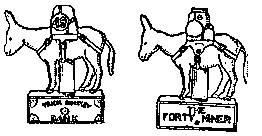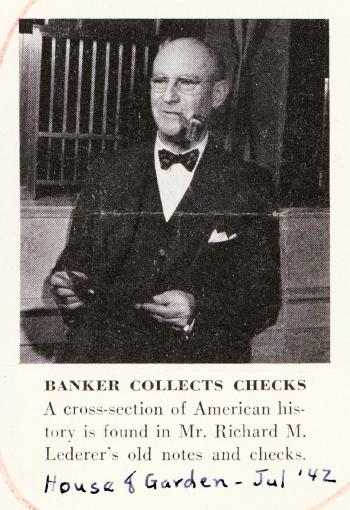COLLECTORS ROUNDUP ó April 1947
The Mechanical Banker
Part VI
 When
I first started collecting, people used to caution me, "Look out for
fakes"; but the more I collect, the fewer fakes I find. This is possibly
for the reason that a "fake" is hard to define. I have heard of only
one bank which, I am told, was made for the sole purpose of selling a small
number at a high price to collectors. This bank, known as the Carnival bank,
portrays a man working a hit-the-bell carnival device. The exact details are
shrouded in mystery, but I understand that only 3 copies of this bank were made
and sold to as many prominent collectors. The Trick Donkey bank is a legitimate
bank in which a donkey standing on a box wiggles his ears and moves his tail
when a coin is inserted in his pack. There was a cigar cutter, very similar in
appearance, but bearing the words "Forty-Niner" cast into the box.
Some unscrupulous person took out the cutting device and put in a coin chute.
This assembly is a fraud, not a real bank in any sense, and not one which should
fool any collector. The William Tell with cross-bow is a bank about which there
is considerable discussion and difference of opinion. The crossbow is William
Tellís traditional weapon, but the usual models show him using a musket to
shoot the apple from his sonís head. As the known specimens of the crossbow
model differ, it is generally assumed that they are later additions or factory
samples and not commercially produced banks. The Dinah with hat is believed to
be a home-made variety also. A still bank with such a hat was manufactured by
the same company and collectors feel that this one specimen must have been a
combination of the two.
When
I first started collecting, people used to caution me, "Look out for
fakes"; but the more I collect, the fewer fakes I find. This is possibly
for the reason that a "fake" is hard to define. I have heard of only
one bank which, I am told, was made for the sole purpose of selling a small
number at a high price to collectors. This bank, known as the Carnival bank,
portrays a man working a hit-the-bell carnival device. The exact details are
shrouded in mystery, but I understand that only 3 copies of this bank were made
and sold to as many prominent collectors. The Trick Donkey bank is a legitimate
bank in which a donkey standing on a box wiggles his ears and moves his tail
when a coin is inserted in his pack. There was a cigar cutter, very similar in
appearance, but bearing the words "Forty-Niner" cast into the box.
Some unscrupulous person took out the cutting device and put in a coin chute.
This assembly is a fraud, not a real bank in any sense, and not one which should
fool any collector. The William Tell with cross-bow is a bank about which there
is considerable discussion and difference of opinion. The crossbow is William
Tellís traditional weapon, but the usual models show him using a musket to
shoot the apple from his sonís head. As the known specimens of the crossbow
model differ, it is generally assumed that they are later additions or factory
samples and not commercially produced banks. The Dinah with hat is believed to
be a home-made variety also. A still bank with such a hat was manufactured by
the same company and collectors feel that this one specimen must have been a
combination of the two.
The paint on banks becomes chipped and worn with time and may have been repainted. Are repainted banks to be considered fakes? I think not, but a repaint should not have the same value as one with the original paint, no matter how badly chipped.
Others become broken. Men with founding and welding equipment are able to repair broken parts and replace missing ones. The dividing line between a greatly repaired bank and a fake is a moot one. I know of two men who specialize in repairing banks, Dr. A. W. Pendergast of Terre Haute, Indiana and Sigmund Dickowski of Newark, New Jersey. These men are both reputable and, I am told, restrict themselves to 10% repair. This proportion is considered legitimate by most collectors. Should there be others without scruples, either operating now or in the future, we collectors would have to be on the alert.
The value of a bank is affected by its paint and mechanical condition as well as by its rarity. The greater the departure from factory fresh, the less the value. When offering banks for sale, some dealers have the habit of writing, "I have a so-and-so bank, what is your offer?" In my opinion this is an unfair way of doing business. Selling antiques is a dealerís business; he should know his product and the markup necessary. It appears that the dealer is asking us to appraise the bank so that he can match bids or set an appropriate price on his bank for sale in his store. Occasionally a bank turns up in the hands of an individual who has no idea of its value, he is not a dealer and is not expected to know. I feel in this case that the potential buyer is morally obligated to set a fair price on the item. If dealers would write describing the bank and the price expected, their knowledge and integrity would be more greatly respected. One dealer, Henry W. Miller of Mt Vernon, N. Y. has definite prices. He sells banks on a commission basis. Rarely buying or selling for his own account, he tries to get buyer and seller together by means of a bid and asked offering sheet. Although his circulation is as yet limited and consequently not a complete picture of the market, his sheets clearly show the price at which someone is willing to buy or another willing to sell a bank. Many other dealers have offering sheets, the prices on them are definite and cannot be traded against. A collector has confidence in one who knows his values and sticks to them. Another sore spot with me is the dealer whose banks in his store are marked with coded prices. The price he gives a buyer is one which he would like to get but he will reduce it to a reasonable figure to make the sale. If I buy a pair of shoes, I try them on. If they fit I pay the price with no questions asked. Why canít we trade in banks the same way? In the field of dealing in and collecting antiques we meet the same people time and time again. I would feel very much ashamed should I see again a person I had cheated, and conversely I have become very friendly with reputable dealers with whom it is a pleasure to do business
Also see:
1940s Richard M. Lederer, text
from manuscripts and letters
1946 Richard M. Lederer, Jr.
- Collectors
Roundup, September Article,
Part I
1946 Richard M. Lederer, Jr.
- Collectors
Roundup, Part III
1946 Richard M. Lederer, Jr.
- Collectors
Roundup, December Article,
Part IV
1947 Richard M. Lederer, Jr. - Collectors
Roundup, March Article, Part V
1950 IBM
Magazine

